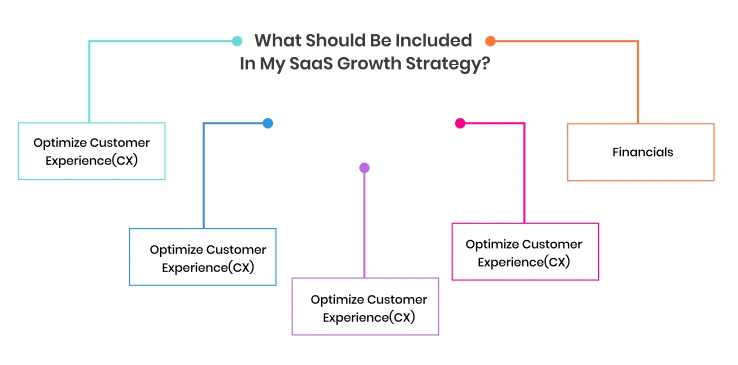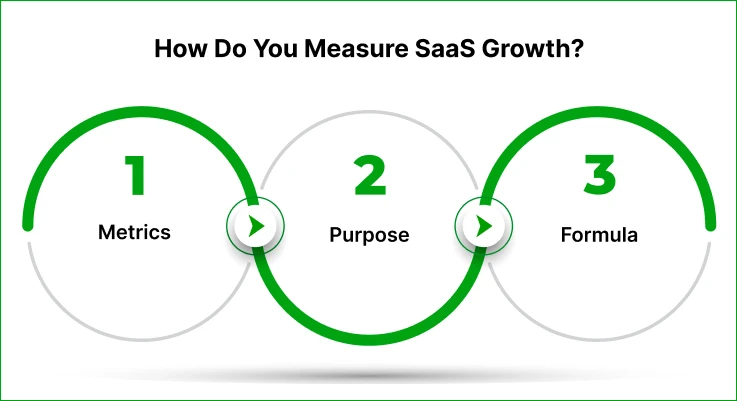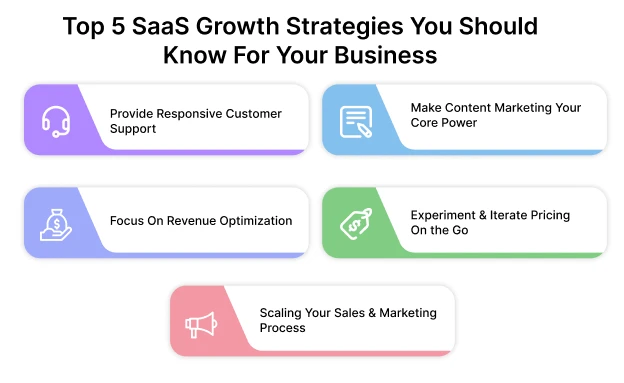 SAAS
SAAS

29 February, 2024

The global SaaS market is now projected to grow from $273.55 billion in 2023 to $908.21 billion by 2030, with an annual rate of 18.7%. Do you know what’s the secret here? Beyond any doubt, adopting a well-defined growth strategy. But finding the perfect growth strategy can feel overwhelming. Relax! Here we’re for you with deep insights and expertise to guide you towards success.
So, what’s the best SaaS growth strategy for your business in 2024? It’s quite straightforward! Focus on customer retention and personalized user experiences. Leverage data analytics to understand your user preferences and enable solutions to enhance engagement and loyalty.
But that’s not the end here! Keep on reading and explore many more secrets with us to unlock your SaaS growth potential, especially in this ever-changing landscape of the industry!
Contents

In general terms, SaaS growth strategies are go-to-market strategies that include all the plans, tactics, and actions that lead to scaling up your SaaS business.
Though the process is comprehensive but must comprised of these three key elements:
Market Strategy: Scaling up to a SaaS firm is not possible without a solid market plan. This involves identifying market trends, knowing about your targets, and focusing on marketing efforts to reach the target.
Product Strategy: The product is the core of your SaaS business. So it is needed to build a strong product strategy to solve target user needs and stand out from competitors.
Go-to-market Strategy: It essentially acts as a roadmap that outlines how your company will introduce itself to the world and attract clients.
The number of SaaS companies is rapidly increasing. There were between 30,000-72,000 SaaS companies globally by the end of 2023, and it is projected that up to 85% of business will be SaaS-based within 2025.
So, you can understand how difficult it would be to stand out in this vast and ever-growing pool of competitors. A specific, measurable goals set will be a lifesaver for you here. It will help you with:

A good SaaS growth strategy should include solid plans that will prove effective for consistent growth and overcome challenges in the industry.
For instance, you can check out the following:
First concentrate on the goals of your business through which you will be able to define your ideal customer, their needs, and preferences. It will help you to implement a full-proof plan to develop services that meet their needs.
A properly aligned product roadmap has the potential to increase business growth by up to 34.2%. So, study and research your customers and evaluate how your SaaS product offering solves their key issues.
Through this, you can refine your plan to better meet your market’s needs.
As with evaluating customers, must determine your sales and CS hiring plans. Choose relevant Key Performance Indicators (KPIs) to measure progress and identify areas for improvement.
Did you know up to 86% of consumers leave a brand just due to poor customer experience? It is like a backbone for any SaaS business. Don’t miss to track down your customer communication and identify areas for improvement to make informed decisions about your SaaS strategy.
Last but not least, you will need to be fully assured about well-proof financial goals. For instance, just go through all your marketing steps and eliminate the metrics or processes that are not useful or are just garbage there. keep track of your finances in a balance sheet or income statement sheet.

When you are trying to know how well your business is running, it is key to measure your SaaS growth. Measuring SaaS growth is quite straightforward as long as you know the right metrics and formula to apply those.
Here are some major SaaS metrics, you should know about!
| Metrics | Purpose | Formula |
| Customer Acquisition Cost (CAC) | Measures the cost of acquiring a new customer | All sales and marketing costs/ Total number of New Customers |
| Customer lifecycle value (CLV) | Measures the number of valuable customers | Customer value* Average Customer Lifespan |
| Annual Recurring Revenue (ARR) | Tracks the predictable recurring revenue generated annually. | MRR * 12 |
| Customer churn | Measures the number of customers who stop using your service within a specific period. | (Lost Customers ÷ Total Customers at the Start of Period) x 100 |
| Average revenue per user (ARPU) | Tracks the average revenue generated per user over a specific period. | Total Revenue / Number of Users |

Whenever you are growing your next SaaS marketing strategy, plans to retain existing customers should be your top priority to elevate your success.
Well, it is not bad to grab new customers, but you may be surprised that up to 65% of a company’s business is built through repeat customers. Plus Forbes says that improving the customer retention rate by 5% increases sales by up to 25-95%
And amazing part is that: 82% of companies agree that it is far cheaper than acquisition.
So, why not try first?
However, the first trick would be here is to make your customer always happy. This would be possible by ensuring end-to-end experience for users, leading to actively fostering strong, positive relationships with existing customers.
For instance, here are some well-proof techniques you can follow:
Gartner report reveals that repurchasing or product renewal chances increase up to 82% only by ensuring top-notch customer value. Even 97% of possibility of them that they will engage in positive word-of-mouth recommendations.
So you can understand how essential is to offer responsive customer support! Well, to ensure responsive customer support, you need to:
Facilitating good customer service won’t be enough as long as you have a productive support team to manage your customers.
According to Salesforce research, up to 63% of consumers expect businesses should Know their unique needs and preferences, rather than treating them as just another generic customer.
In this instance, building a strong customer support team is pivotal.
So make your team members properly trained to not only retain customers but foster your sales growth by ensuring stronger bonding.
Is your SaaS business continuously falling and more likely customers are showing interest in your broad? You may lack an onboarding system. Even you are not alone here.
The shocking case is, that up to 55% of customers stop using a product just because service they don’t understand.
So while developing your next SaaS growth strategy, make sure you are not missing this key element. Make such an effective onboarding process, through which your customer can easily get through your product. Get an example from Asana.
Upon signing up, they provide an interactive tutorial that guides users through the key features and functionalities of the platform. It’s truly amazing!!
When the fact is about improving brand visibility and attracting potential customers, effective content marketing is the key to there!
Content marketing helps it easier to rank your SaaS product higher in the search engine results pages (SERPs).
Also, through informative content like blog posts, webinars, and ebooks, you can position your company as an expert in your industry as well as build trust with your potential customers.
For instance, here are some key considerations that you should know first!
Understanding your target audience: Know all about your audience first, who will go to search for your product or could benefit from your product.
Leverage Unique Data: Whether it is a blog post or product script, ensure it is not just a generic combination of words. You should focus on leveraging their unique data and authentication information, what your audience needs.
Utilize Video Marketing: As a SaaS business owner, you should know that, Video marketing has a direct impact on your sales growth.
Up to 84% of consumers watch online videos before purchasing to make them more knowledgeable about a product. So don’t forget to utilize it as much as possible.
In the revenue era, all your sales and marketing efforts are certainly related to generating revenue. But is it so easy to reach out to the target revenue?
Yes, possible! With a strategic SaaS growth plan.
While focusing on customer acquisition and retention is important, optimizing revenue streams is equally important here.
The Rule of 40, by Brad Feld, will define exactly what I mean to say.
It tells that SaaS companies with an above 40% profit rate are considered sustainable whereas companies below 40% face cash flow or ultimately get liquidated. So organising revenue rates specific to a SaaS business is crucial. For instance, here are a few proven key strategies you can keep in your mind:
Start focusing on your sales and marketing strategy. Here you can utilize the upselling and cross-selling strategy.
Upselling is what increases the transaction value and revenue by offering customers exclusive features on your product with higher-tier plans.
Conversely, cross-selling focuses on selling related or complementary products to a customer alongside their initial purchase.
This increases the average order value and drives revenue growth without even your additional cost on customer acquisition.
Suppose you have enough customers for your existing business. How would that be when you can leverage these existing customers as a reference to engage their friends, colleagues, or contacts and get to your SaaS product?
That’s what is the implementation of referral programs and it is crucial to add in your SaaS growth strategy.
Here’s a noteworthy example: Zoom. During the pandemic, this video conferencing platform witnessed a widespan growth (up to 2900%) through just its well-structured referral program.
When you are thinking about maximizing your revenue growth, make sure you have implemented an effective pricing tier for your SaaS product.
Offering pricing tiers with your different plans and subscription costs can drive significant revenue growth while attracting and retaining a broader range of customers. However, to implement effective pricing tiers for a SaaS business, you can consider things like:
All of the above, make sure to understand the value of the product that you are going to provide to your users or buyers.
This metric is crucial in the pricing tiers of your SaaS product. Inspect carefully your customer acquisition scopes and how much you are spending there to get them engaged.
A 2020 report found that found that companies with a freemium pricing model were able to increase conversion rates by 25% compared to companies with not!
So, check and ensure whether you have a freemium model for your SaaS product.
This would be like you are allowed to test the premium product of your grocery shop as a free trial.
Users tend to pay again for a product that they have already tried before! So don’t miss to try it.
In the SaaS industry, companies typically spend between 30% and 60% of their revenue on sales and marketing activities. So, while optimizing the SaaS growth strategy to scale up your business, you should focus on your sales and marketing process and optimize it as needed.
Here is how you can do so:
The sign-up process is like a door to enter your SaaS world. So it is essential to make an entrance as much easier and convenient as you can. For instance, here are some key practices you can consider:
While just engaging new customers is not enough, retaining them through building trust has the same value. So how can it be possible?
With the help of SaaS review sites. Even it is proven that up to 77% of B2B purchasers like to do their own research rather than talking to a salesperson.
So, build a review site, highlighting all the needed details about your SaaS platform as well as making your business responsive through authentic customer feedback.
This is the key to driving lead and upscaling your SaaS product sales growth to the next level.
Up to 90% of businesses find this marketing strategy effective for their brand exposure and 75% of them witnessed amazing sales growth. So make sure to create engaging and shareable which can drive leads from the social media platforms as well.
Remember, SaaS success lies not just in with an efficient customer acquisition, but in understanding the user’s needs, and adapting the solution to address their issues. Only after that you can scale your sales process and reach your dream revenue goal. All you need right approach!
While the perfect growth strategy might seem tricky for you, with the right guidance you can unlock this potential easily. Our comprehensive guide would be a roadmap for you to craft your 2024 SaaS growth strategy, leading to sustainable business growth in the years to come!!!
Check also: 18 Best Sentiment Analysis Tools to Decode Emotions